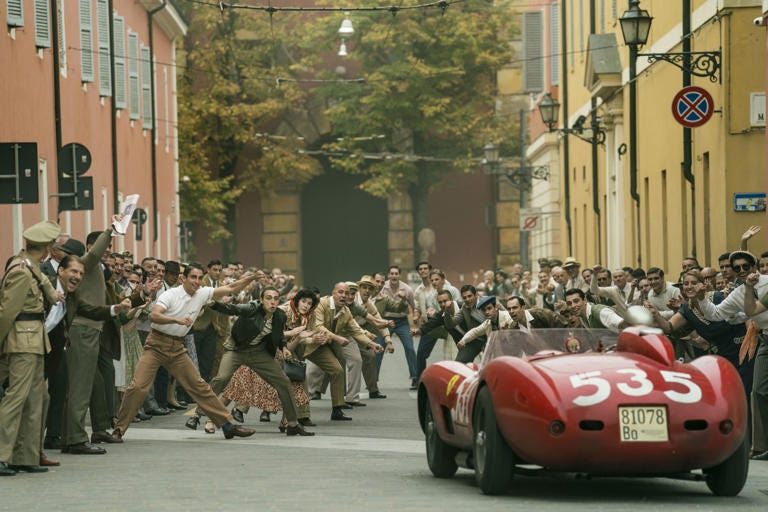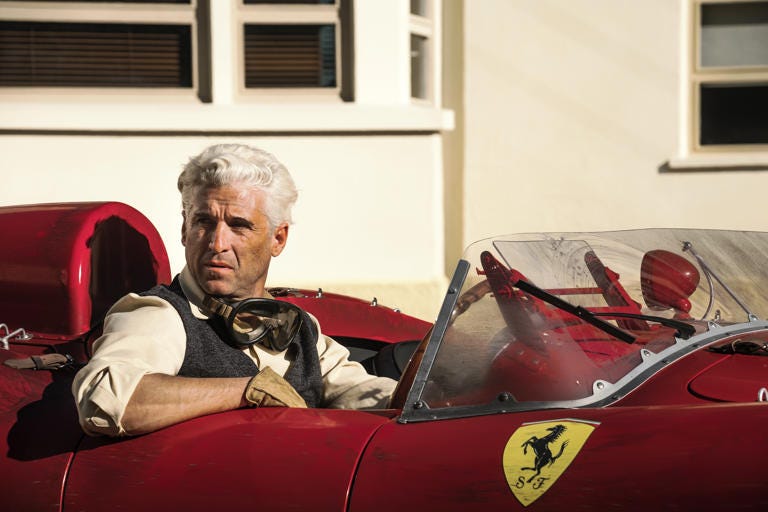Ferrari (Dir Michael Mann) 124 minutes B&W/Colour.
In which Michael Mann finally gets to deliver his long gestated project about Enzo Ferrari and the crucial moment in 1957 which defines his life.
.Synopsis
1957: Enzo Ferrari (Adam Driver) has reached a crisis point. His dominance of the world record is under threat from Maserati and he must win the Mille Miglia race (1000 miles through the Alps and Northern Italy) if he is to stave off bankruptcy and lose his business which he co-owns with his wife (Penelope Cruz) who he no longer loves. Meanwhile, he has a 12 year old son by his mistress (Shailene Woodley) and is under pressure whether to publicly acknowledge the son, but doing so would also antagonise his wife and destroy his business.
Assessment
Michael Mann has been working on this project for over 20 years. In fact the script writer; Troy Kennedy Martin (Edge of Darkness) died in 2009! It has gone through several lead actors including Christian Bale and Hugh Jackman as Enzo and Noomi Rapace as Laura. All fine actors, but I’m more than comfortable with Adam Driver and Penelope Cruz as the lead characters. They are superb in their roles and the scenes where they try and negotiate their complex relationship are brilliant pieces of cinema as you’ll see from this short clip.
It’s stating the obvious to say that this is an important film for Michael Mann. In fact he has been quoted as calling it his follow up to The Last of the Mohicans. I’ll make no bones about my admiration for much of his portfolio. Last of the Mohicans, Heat, Thief, Manhunter, The Insider & Collateral rank among the best films in post 60’s American cinema. He is up there with Martin Scorsese & Ridley Scott as an auteur who has an individual style and is open in his admiration for directors like Kubrick, Peckinpah, Ford & Hawks. Indeed, he is like an amalgam of all 4. His output in the the last decade or so has been slightly disappointing: Miami Vice, Public Enemies were flawed and the latter overlong, but this new movie is right up there with those earlier films.
What Mann brings to a film is an intensity, often with an incredible sense of style (the Miami Vice tv series was very much his vision) a rigor in getting his period detail correct and the integration of sound and visuals in a way few directors can manage. His subject is usually centred around a driven man, who is out of sync with his times, a man whose focus results in difficult decisions about what is important to him. It’s fair to say, there’s a lot of testosterone in his films. All of this is present in Ferrari, but what the 80 year old Mann adds for the first time is a female character who is as important to the narrative as the male one. He has given good roles to women before (Madeleine Stowe in LATM or Diane Venora and Ashley Judd in Heat), but men drive the plot. Here, it’s much more balanced. There is a beautiful mirrored scene early in the film, where both Enzo and Laura visit their son’s tomb and show their grief in subtly different ways: he, all words finally broken by weeping, her by a smile that becomes a tear. From that you know the film is about both of them.
While the film is about car racing and creating these beautiful machines, it is even more a film about death and obsession. Both main characters are haunted by the death of their son, Enzo is also a surviving twin whose mother tells him the wrong brother died. The workers go to mass to sanctify their machines and there is an incredible scene where Enzo tells his drivers he expects them to die if need be to win. In another moving scene, they all write final letters to their loved ones in their hotel rooms before the big race. The crowds are so close to the cars you are almost screaming at them to stand back.
Finally there is a dramatic crash with appalling consequences. I don’t think I have ever seen a film about motor racing as good as this which conveys the permanent sense of danger and the sheer physical challenge of driving a car at speed for so long. The racing scenes are dramatic and often use small details like a car wing or tyre to dramatize the jeopardy.
There has been some criticism of the film. Some feel it is slow, but that misses the central purpose. It is the story of someone who is obsessed to the point of inhumanity with one objective being faced with a moment where he has to allow other things into his life. It is also about a woman who has to decide if revenge will be enough. As Enso says “Two objects cannot occupy the same space at the same moment in time”. Something has to give.
It is a beautiful film to look at. Shooting in Northern Italy of course helps, but the scarlet cars stand out against the scenery. Given their rarity and vintage, the cars used in the film had to be built from scratch, but he uses the sound of the real vehicles to create an authentic atmosphere. Older cameras are attached to the cars which are driven at 140mph so you get a very real sense of the jerkiness of the vehicle. Both Mann and Patrick Dempsey are petrolheads and have competed in races like these in real life so there is an authenticity to the action.
Mann does not like to use digital extras even though he was one of the earliest proponents of digital filming (he likes the depth of field it gives him and the ability to use low light), so most of what you see is not CGI. The famous crash which killed 9 spectators as well as the 2 men in the car is recreated with astonishing fluency and is up there with the shootout in Heat of the Indian attack in Last of the Mohicans for it’s visceral impact. Erik Messerschmidt, who did such wonderful work on Mank is the cinematographer and his use of deep focus is stunning. Daniel Pemberton’s score ( He co-wrote the theme to Slow Horses by the way), incorporates the roar of the car engines with high-pitched strings and low-frequency bass. It’s as if the cars are screaming at the torture they are being put through.
And like all great movies, the first couple of minutes tell you so much about the film. Enzo wakes in bed and quietly goes off to work leaving his family sleeping, only we don’t know it is his hidden family until the next scene. There is a lovely scene where Enzo is at the opera and we see what La Traviata (the story of someone trying to leave their old life behind to find new happiness) being performed on stage conjures up in him. His mistress, relegated to the circle for decorum, also has her vision as does in turn, his wife and mother across the road in their mansion. Beautifully done.
I don’t know why there have been 3 major biopics this year (Napoleon, Bernstein and now Ferrari) which are not really about the thing the subject is famous for, but about their relationship with their spouse. For me, Ferrari is the best of the three.







I meant to add that it's very much a movie of stasis and movement. People who are stuck while all around is speed